
Donetsk Oblast, also referred to as Donechchyna (Донеччина), is an oblast in eastern Ukraine. It is Ukraine's most populous province, with around 4.1 million residents. Its administrative centre is Donetsk, though due to the ongoing Russo-Ukrainian War, the regional administration was moved to Kramatorsk. Historically, the region has been an important part of the Donbas region. From its creation in 1938 until November 1961, it bore the name Stalino Oblast as Donetsk was then named "Stalino", in honour of Joseph Stalin. As part of the de-Stalinization process, it was renamed after the Siversky Donets river, the main artery of Eastern Ukraine. Its population is estimated as 4,100,280

The Seversky Donets or Siverskyi Donets, usually simply called the Donets, is a river on the south of the East European Plain. It originates in the Central Russian Upland, north of Belgorod, flows south-east through Ukraine and then again through Russia to join the river Don, about 100 km (62 mi) from the Sea of Azov. The Donets is the fourth-longest river in Ukraine, and the largest in eastern Ukraine, where it is an important source of fresh water. It gives its name to the Donets Basin, known commonly as the Donbas, an important coal-mining and industrial region in Ukraine.

Donetsk, formerly known as Aleksandrovka, Yuzivka, Stalin and Stalino, is an industrial city in eastern Ukraine located on the Kalmius River in Donetsk Oblast. The population was estimated at 901,645 in the city core, with over 2 million in the metropolitan area (2011). According to the 2001 census, Donetsk was the fifth-largest city in Ukraine.
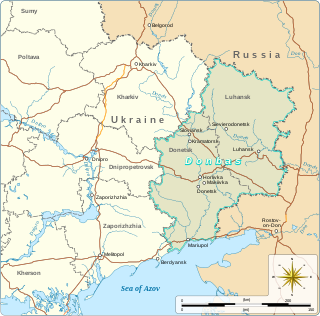
The Donbas or Donbass is a historical, cultural, and economic region in eastern Ukraine. Parts of the Donbas are occupied by Russia as a result of the Russo-Ukrainian War.

Vasyl' Stus Donetsk National University (Vasyl' Stus DonNU) (Ukrainian: Донецький національний університет імені Василя Стуса, Donets’kyi Natsional’nyi Universytet; Russian: Донецкий национальный университет имени Василия Стуса) one of the leading higher educational institutions of Ukraine. The university's history starts in 1937 from the moment of creation of a pedagogical institute in Donetsk (then Stalino). In 1965, the institute was transformed into Donetsk State University. It was accorded the National status in 2000.

The Donetsk–Krivoy Rog Soviet Republic or Donetsk–Kryvyi Rih Soviet Republic was a self-declared Soviet republic of the Russian SFSR proclaimed on 12 February 1918. It was founded three days after the government of the Ukrainian People's Republic (UPR) signed its Treaty of Brest-Litovsk with the Central Powers, which recognised the borders of the UPR. Lenin did not support the creation of the entity and neither did Sverdlov. Some other Bolsheviks like Elena Stasova, however, sent a telegraph of best wishes.
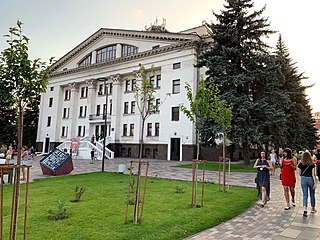
Donetsk Academic Regional Drama Theatre was a theatre in Mariupol in southern Ukraine. The modern theatre was constructed in 1960 in the approximate location of the former Church of Mary Magdalene. The theatre was largely destroyed by Russian airstrikes on 16 March 2022, resulting in the deaths of around 600 people.

Eastern Ukraine or east Ukraine is primarily the territory of Ukraine east of the Dnipro river, particularly Kharkiv, Luhansk and Donetsk oblasts (provinces). Dnipropetrovsk and Zaporizhzhia oblasts are often also regarded as "eastern Ukraine". In regard to traditional territories, the area encompasses portions of the southern Sloboda Ukraine, Donbas, the eastern Azov Littoral (Pryazovia).

The 383rd 'Miners' Rifle Division was a formation of the Red Army, created during the Second World War. The division was officially created on 18 August 1941. It was given the name Shakhterskaya, as it was originally composed completely of miners from the Donets Basin, Ukrainian SSR. During the course of the war, its losses were continually replaced, and thus it began to consist not only of miners from Donbas.

The Ukrainian Catholic Archiepiscopal Exarchate of Donetsk is one of the Ukrainian Greek Catholic Church 's five Archiepiscopal Exarchate in Eastern Ukraine.

To Donbas Liberators is a monument in Lenin Komsomol park, Donetsk, dedicated to military units and formations participating in the ousting of Wehrmacht from Donbas during World War II. It is the largest monument in the south-east of Ukraine, the main military history monument of the city and region.
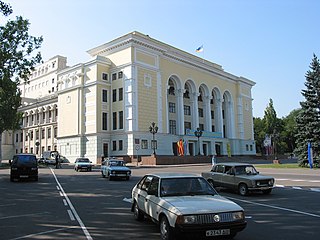
Donetsk State Academic Opera and Ballet Theatre named after A. Solovyanenko was established in 1932 in Donetsk on the basis of fit-up theatre of Right-bank Ukraine. Since 15 March 1932 the theatre was transferred to Donetsk theatre group The first season opened on September 1, 1932 with opera Prince Igor composed by Alexander Borodin. On April 12, 1941, the Theatre opened the season in the new theater building by premiere of Mikhail Glinka's Ivan Susanin. On August 7, same year, the premiere of the first ballet performance Laurencia by Alexander Crain was held.
Donetsk Ballet is a ballet company based in the city of Donetsk, Ukraine. Donetsk Ballet performs works of classical ballet and contemporary dance. The company tours internationally.

Mark Brovun was a Ukrainian cultural employee, awardee of Taras Shevchenko National Prize of Ukraine, Art Director of Donetsk National Musical and Drama Theatre.

The Donbas strategic offensive was the second of two strategic operations of the Soviet Red Army on the Eastern Front of World War II,, with the goal of liberating the Donetsk Basin, or Donbas, from the forces of Nazi Germany.
Donbas separatism is separatist sentiment in the southeast of Ukraine. According to proponents, there is a "common historical, cultural and economic region of Donbas". According to the authors of the concept of the region "is committed to the formation of autonomous and independent states on the territory of Donbas".
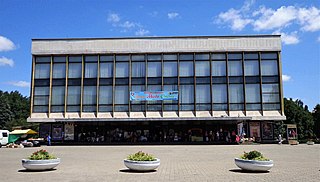
Dnipropetrovsk Academic Opera and Ballet Theatre is an opera house in Dnipro.

The Young Guard is an opera in four acts and seven scenes by the Ukrainian composer Yuliy Meitus, with a libretto by Andriy Malyshko.
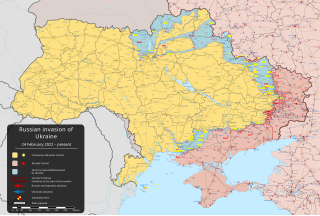
Below is a topical outline of articles significantly or meaningfully related the Russo-Ukrainian War; it is not an outline of articles related generally to Russian–Ukrainian relations. The Related outlines section contains links to other outlines related to the Russo-Ukrainian War. This outline is a topical organization of articles; for a chronological organization, please see the Timelines section below.



















